How Many Single Family Homes Were Destroyed Earthquakes in California?
Domicile » Earthquakes » California
California Convulsion Map Drove
Isoseismal Maps for Selected California Earthquakes
Kern County Convulsion - 7.three - July 21, 1952
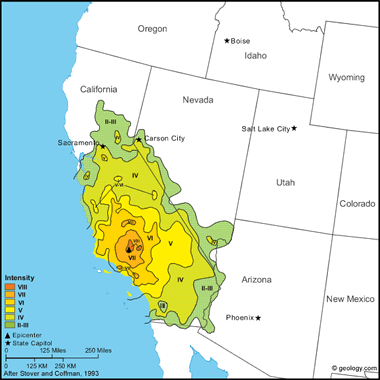
Kern County Earthquake, 1952: This earthquake was the largest in the conterminous Usa since the San Francisco shock of 1906. It claimed 12 lives and caused property damage estimated at $sixty 1000000. MM intensity XI was assigned to a small area on the Southern Pacific Railroad southeast of Bealville. There, the earthquake cracked reinforced-concrete tunnels having walls 46 cm thick; it shortened the distance between portals of two tunnels virtually ii.5 meters and bent the rails into Due south-shaped curves. At Owens Lake (most 160 kilometers from the epicenter), table salt beds shifted, and brine lines were bent into S-shapes.
Many surface ruptures were observed along the lower slopes of Acquit Mountain, in the White Wolf error zone. The somewhat flat, poorly consolidated alluvium in the valley was erratically croaky and recontoured. The swell along Bear Mountain indicated that the mountain itself moved upward and to the north. Southwest of Arvin, on the San Joaquin Valley floor, basis cracks traversed and dissever the concrete foundation of 1 house, causing partial collapse. The ground slumped; cotton rows were first more than thirty centimeters; and pavement on one highway was crumpled for more than 300 meters. Due east of Caliente, one big crack, most i.five meters at its widest point and more than 60 centimeters deep, was observed. Fill up areas in the mountainous region forth U.S. Highway 466 (now Throughway 58) settled from a few centimeters to more than 30 centimeters in places, and a large part of the highway was croaky and wrinkled. Northeast of that highway, the ground was displaced vertically virtually 60 centimeters and horizontally about 45 centimeters.
Maximum MM intensities in nearby cities did not exceed 8. At Tehachapi, Bakersfield, and Arvin, old and poorly built masonry and adobe buildings were croaky, and some collapsed.
Holding damage was heavy in Tehachapi, where both brick and adobe buildings were hit difficult, and 9 people were killed. Three people were killed in other towns. Although impairment was severe, the full extent of damage to property did non exceed that in Long Beach in 1933. Only a few woodframe structures were damaged seriously in this earthquake, compared to the 1933 shock in which many such structures were thrown off foundations.
The by and large moderate harm in Bakersfield was confined mainly to isolated parapet failure. Cracks formed in many brick buildings, and older school buildings were damaged somewhat. In contrast, however, the Kern General Infirmary was damaged heavily. Multistory steel and concrete structures sustained pocket-size harm, which commonly was bars to the first story. Similar kinds of harm too occurred at Arvin, which lies southeast of Bakersfield and west of Tehachapi.
Reports of long-catamenia moving ridge effects from the earthquake were widespread. H2o splashed from swimming pools every bit far afar as the Los Angeles surface area, where harm to tall buildings was nonstructural but all-encompassing. Water also splashed in pressure level tanks on tops of buildings in San Francisco. At least i edifice was damaged in San Diego, and in Las Vegas, Nevada, a building under construction required realignment of the structural steel.
The master shock was felt over most of California and in parts of western Arizona and western Nevada. Information technology was observed at such afar points as Stirling City, California, Phoenix, Arizona, and Gerlach, Nevada. The California Institute of Engineering science at Pasadena recorded 188 aftershocks of magnitude 4.0 and higher through September 26, 1952; six aftershocks on July 21 were of magnitude 5.0 and higher. (from: United States Geological Survey Professional Paper 1527: Seismicity of the United States, 1568-1989, (revised), by C.West. Stover and J.L. Coffman, 1993, 418 pages) Larger map
Presented below is a collection of intensity maps and descriptions for several California earthquakes. The maps show the geographic distribution of ground shaking as gauged by the Modified Mercalli Intensity Scale. The maps were produced by obtaining intensity values from many locations within the felt area of the earthquake, plotting them on the map, and then contouring that data.
If yous read the descriptions that accompany the maps, yous volition learn that the San Andreas Mistake played an important office in almost of California's large earthquakes.
The maps and descriptive accounts were first published equally part of United States Geological Survey Professional Newspaper 1527: Seismicity of the United states, 1568-1989, (revised), past C.W. Stover and J.L. Coffman, 1993, 418 pages. The maps shown here were created by Brad Cole using Stover and Coffman'south original work, merely redrafting to a common scale and format that allows piece of cake comparison.
Modified Mercalli Intensity Scale
Two. Felt only past a few persons at rest, specially on upper floors of buildings.
Iii. Felt quite noticeably by persons indoors, specially on upper floors of buildings. Many people exercise non recognize it as an convulsion. Standing motor cars may rock slightly. Vibrations like to the passing of a truck. Elapsing estimated.
IV. Felt indoors by many, outdoors past few during the 24-hour interval. At night, some awakened. Dishes, windows, doors disturbed; walls make cracking sound. Sensation like heavy truck striking building. Standing motor cars rocked noticeably.
Five. Felt by nearly everyone; many awakened. Some dishes, windows broken. Unstable objects overturned. Pendulum clocks may terminate.
Vi. Felt by all, many frightened. Some heavy article of furniture moved; a few instances of fallen plaster. Damage slight.
Seven. Damage negligible in buildings of good design and construction; slight to moderate in well-congenital ordinary structures; considerable harm in poorly built or desperately designed structures; some chimneys broken.
8. Damage slight in specially designed structures; considerable harm in ordinary substantial buildings with partial plummet. Damage groovy in poorly built structures. Autumn of chimneys, mill stacks, columns, monuments, walls. Heavy furniture overturned.
IX. Harm considerable in specially designed structures; well-designed frame structures thrown out of plumb. Damage great in substantial buildings, with partial collapse. Buildings shifted off foundations.
Ten. Some well-built wooden structures destroyed; most masonry and frame structures destroyed with foundations. Track bent.
Eleven. Few, if whatsoever (masonry) structures remain standing. Bridges destroyed. Runway bent greatly.
XII. Damage full. Lines of sight and level are distorted. Objects thrown into the air.
Fort Tejon Convulsion - 7.9 - January 9, 1857
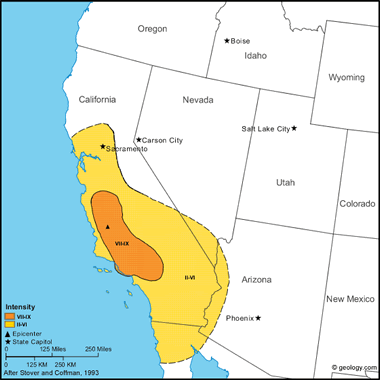
Fort Tejon Earthquake, 1857 This earthquake occurred on the San Andreas error, which ruptured from near Parkfield (in the Cholame Valley) virtually to Wrightwood (a distance of well-nigh 300 kilometers); horizontal displacement of as much equally 9 meters was observed on the Carrizo Manifestly. Information technology acquired one fatality. A comparison of this shock to the San Francisco earthquake, which occurred on the San Andreas fault on Apr. 18, 1906, shows that the mistake break in 1906 was longer but that the maximum and average displacements in 1857 were larger.
Belongings loss was heavy at Fort Tejon, an Regular army post well-nigh 7 kilometers from the San Andreas fault. Two buildings were alleged unsafe, 3 others were damaged extensively but were habitable, and even so others sustained moderate harm. About twenty kilometers west of Fort Tejon, copse were uprooted, and buildings were destroyed between Fort Tejon and Elizabeth Lake. One person was killed in the plummet of an adobe house at Gorman. Stiff shaking lasted from 1 to 3 minutes.
Instances of seiching, fissuring, sandblows, and hydrologic changes were reported from Sacramento to the Colorado River delta. Ground fissures were observed in the beds of the Los Angeles, Santa Ana, and Santa Clara Rivers and at Santa Barbara. Sandblows occurred at Santa Barbara and in the flood plain of the Santa Clara River. One report describes sunken copse, possibly associated with liquefaction, in the area between Stockton and Sacramento. Changes in the menstruum of streams or springs were observed in the areas of San Diego, Santa Barbara, Isabella, and at the south terminate of San Joaquin Valley. The waters of the Kern, Lake, Los Angeles, and Mokulumne Rivers overflowed their banks. Changes in the flow of water in wells were reported from the Santa Clara Valley in northern California. Felt from Marysville south to San Diego and east to Las Vegas, Nev. Several slight to moderate foreshocks preceded the chief daze by one to 9 hours. Many aftershocks occurred, and two (January 9 and 16) were large enough to accept been widely felt. NOTE: Even though this was a very stiff convulsion the intensity map is simple. This is because there were very few people in this area who wrote their observations. As a result the intensity map shows a general trend with much estimation applied. (from: United States Geological Survey Professional Newspaper 1527: Seismicity of the United States, 1568-1989, (revised), by C.Due west. Stover and J.L. Coffman, 1993, 418 pages) Larger map
Owens Valley Earthquake - 7.4 - March 26, 1872

Owens Valley Convulsion, 1872: The most devastating effects of this convulsion occurred at Lone Pine, where 52 of 59 houses (mostly constructed of adobe or stone) were destroyed and 27 people were killed. A few fatalities also were reported in other parts of Owens Valley. 1 report states that the main buildings were thrown down in nigh every boondocks in Inyo Canton. About 100 kilometers south of Lone Pine, at Indian Wells, adobe houses sustained cracks. Property loss has been estimated at $250,000 in 1872 dollars.
Faulting occurred on the Owens Valley fault along a line a few kilometers east of the Sierra Nevada escarpment. The faulting most Lone Pine involved both dip-slip and right-lateral components of motility. The largest amount of surface deformation was observed between the towns of Lone Pine and Independence, just mistake scarps formed forth a length of at least 160 kilometers - from Haiwee Reservoir, southward of Olancha, to Large Pine; cracks formed in the basis as far north as Bishop. The largest horizontal deportation of vii meters was measured on the error scarps west of Lone Pino. The vertical offsets clearly were smaller, averaging about 1 meter with the downthrown block on the eastward. A comparison of this earthquake to the earthquakes of 1857 and 1906 on the San Andreas fault shows the felt area and maximum mistake displacements to be comparable. Even so, the shocks on the San Andreas fault ruptured the fault for significantly larger distances (300 kilometers in 1857 and 430 kilometers m in 1906).
This earthquake stopped clocks and awakened people at San Diego to the south, Reddish Bluff to the n, and Elko, Nevada, to the east. MM intensity Viii or larger was observed over an expanse of about 25,000 square kilometers, and MM intensity 9 or larger was observed over an area of virtually 5,500 square kilometers. The shock was felt over almost of California and much of Nevada. Thousands of aftershocks occurred, some severe. (from: United states Geological Survey Professional person Paper 1527: Seismicity of the Usa, 1568-1989, (revised), past C.W. Stover and J.L. Coffman, 1993, 418 pages) Larger map
San Francisco Earthquake - 7.eight - Apr 18, 1906
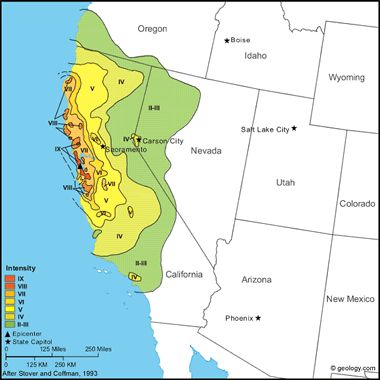
San Francisco Earthquake, 1906: This earthquake is 1 of the near devastating in the history of California. The earthquake and resulting fires caused an estimated 3,000 deaths and $524 million in property loss. Harm in San Francisco resulting only from the earthquake was estimated at $20 1000000; outside the metropolis, information technology was estimated at $4 1000000. The sensible elapsing of the shaking in San Francisco was about 1 minute.
The earthquake damaged buildings and structures in all parts of the city and canton of San Francisco, although over much of the expanse, the damage was moderate in corporeality and character. Most chimneys toppled or were badly cleaved. In the business commune, which was built on ground made by filling in the cove of Yerba Buena, pavements were buckled, arched, and fissured; brick and frame houses of ordinary construction were damaged extensively or destroyed; sewers and water mains were broken; and streetcar tracks were bent into wavelike forms. On or near the San Andreas fault, buildings were destroyed (one was torn apart), and trees were knocked to the basis. The surface of the ground was torn and heaved into furrow-like ridges. Roads crossing the faultline were impassable, and pipelines were broken. I pipeline that carried h2o from San Andreas Lake to San Francisco was cleaved, shutting off the water supply to the city. The fires that ignited shortly afterward the onset of the earthquake quickly raged through the urban center because of the lack of water to control them. They destroyed a large office of San Francisco and intensified the loss at Fort Bragg and Santa Rosa.
This earthquake caused the most lengthy rupture of a error that has been observed in the contiguous The states. The displacement of the San Andreas Error was observed over a distance of 300 kilometers from San Juan Bautista to Signal Arena, where information technology passes out to body of water. Additional displacement was observed farther north at Shelter Cove in Humbolt Canton, and, bold the rupture was continuous, the total length of rupture would extend to 430 kilometers. The largest horizontal deportation - vi.4 meters - occurred near Point Reyes Station in Marin County.
In areas where dislocation of fences and roads indicated the amount of footing movement, motions of iii to 4.v meters were mutual. Near Point Arena, in Mendocino County, a fence and a row of copse were displaced almost v meters. At Wright'south Station, in Santa Clara County, a lateral displacement of 1.iv meters was observed. Vertical deportation of every bit much as 0.ix meter was observed near Fort Ross in Sonoma County. Vertical displacement was not detected toward the southward end of the fault.
Although Santa Rosa lies about 30 kilometers from the San Andreas fault, damage to property was severe, and 50 people were killed. The earthquake also was severe in the Los Banos expanse of the western San Joaquin Valley, where the MM intensity more than 48 km from the fault zone was Nine. Santa Rosa lies directly inland from the region of greatest movement on the San Andreas fault.
Copse swayed violently, and some were broken off above the ground or thrown downwardly. The h2o in springs and artesian wells either increased or decreased its menses. A few sand craterlets formed in areas where water was ejected through cracks or fissures.
The region of destructive intensity extended over a altitude of 600 kilometers. The full felt expanse included most of California and parts of western Nevada and southern Oregon. The maximum intensity of XI was based on geologic furnishings, but the highest intensity based on damage was 9. Several foreshocks probably occurred, and many aftershocks were reported, some of which were severe. (from: United states Geological Survey Professional Paper 1527: Seismicity of the United States, 1568-1989, (revised), past C.W. Stover and J.Fifty. Coffman, 1993, 418 pages) Larger map
Borrego Mountain Earthquake - vi.5 - April ix, 1968
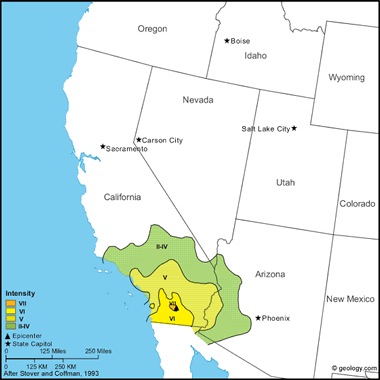
Borrego Mountain Earthquake, 1968: Along the Coyote Creek fault, surface rupture 31 kilometers in length was observed. Highway 78 sustained cracks next to Ocotillo Wells. Rockslides occurred in Palm Canyon, Split up Mountain, and Font'due south Caput in the Anza-Borrego Desert State Park, and huge boulders blocked the Montezuma-Borrego Highway. The walls of one firm at Ocotillo Wells were separate over doorways and at corners of rooms, and the chamber was separated from the remainder of the house. The master daze was felt over a large surface area, including southern California, southwest Arizona, and southern Nevada. Several aftershocks were reported. The largest one knocked plaster to the flooring in a theater at Calexico. (from: United States Geological Survey Professional person Newspaper 1527: Seismicity of the U.s., 1568-1989, (revised), past C.W. Stover and J.Fifty. Coffman, 1993, 418 pages) Larger map
San Fernando Earthquake - 6.half dozen - February 9, 1971
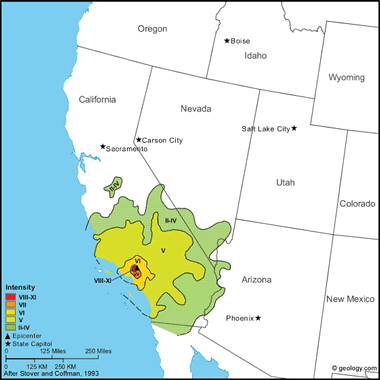
San Fernando Earthquake, 1971 This subversive convulsion occurred in a sparsely populated area of the San Gabriel Mountains, about San Fernando. It lasted most 60 seconds, and, in that brief span of time, took 65 lives, injured more than than 2,000, and acquired property impairment estimated at $505 million.
The earthquake created a zone of discontinuous surface faulting, named the San Fernando fault zone, which partly follows the boundary betwixt the San Gabriel Mountains and the San Fernando-Tujunga Valleys and partly transects the northern salient of the San Fernando Valley. This latter zone of tectonic ruptures was associated with some of the heaviest property damage sustained in the region. Within the entire length of the surface faulting, which extended roughly east-west for virtually 15 kilometers, the maximum vertical starting time measured on a single scarp was about 1 meter, the maximum lateral offset about i meter, and the maximum shortening (thrust component) about 0.9 meter.
The almost spectacular damage included the destruction of major structures at the Olive View and the Veterans Assistants Hospitals and the collapse of throughway overpasses. The newly built, earthquake-resistant buildings at the Olive View Hospital in Sylmar were destroyed, 4 five-story wings pulled abroad from the main building and three stair towers toppled. Older, unreinforced masonry buildings collapsed at the Veterans Assistants Hospital at San Fernando, killing 49 people. Many older buildings in the Alhambra, Beverly Hills, Burbank, and Glendale areas were damaged beyond repair, and thousands of chimneys were damaged in the region. Public utilities and facilities of all kinds were damaged, both higher up and below ground.
Severe basis fracturing and landslides were responsible for extensive harm in areas where faulting was not observed. The most damaging landslide occurred in the Upper Lake area of Van Norman Lakes, where highway overpasses, railroads, pipelines, and about all structures in the path of the slide were damaged severely. Several overpasses collapsed. Ii dams were damaged severely (Lower Van Norman Dam and Pacoima Dam), and iii others sustained minor damage. Widespread landslides and rockfalls blocked many highways in the area.
Felt throughout southern California and into western Arizona and southern Nevada. No foreshocks were recorded, only aftershocks were reported in the expanse for several months. (from: Us Geological Survey Professional Newspaper 1527: Seismicity of the United States, 1568-1989, (revised), by C.Due west. Stover and J.L. Coffman, 1993, 418 pages) Larger map
Long Embankment Earthquake - 6.iv - March 11, 1933
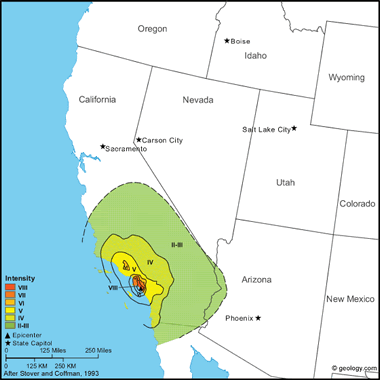
Long Embankment Earthquake, 1933: Although only moderate in terms of magnitude, this earthquake acquired serious damage to weak masonry structures on land fill from Los Angeles south to Laguna Beach. Holding damage was estimated at $40 million, and 115 people were killed.
Severe belongings damage occurred at Compton, Long Beach, and other towns in the expanse. Most of the spectacular structural damage was due to state fill, or deep water-soaked alluvium or sand, and to desperately designed buildings. Minor disturbances of groundwater, secondary cracks in the ground, and slight world slumps occurred, but surface faulting was not observed. Forth the shore between Long Embankment and Newport Beach, the settling or lateral movement of road fills across marshy land caused much damage to the concrete highway surfaces and to approaches to highway bridges.
At Compton, about every building in a iii-block radius on unconsolidated material and land fill was destroyed. At Long Beach, buildings collapsed, houses were pushed from foundations, walls were knocked down, and tanks and chimneys savage through roofs. Damage to school buildings, which were among the structures most commonly and severely damaged by this convulsion, led to the Country Legislature passing the Field Act, which at present regulates building-construction practices in California. This destructive earthquake was associated with the Newport-Inglewood fault. Shocks like in magnitude and intensity to this event accept occurred in this area in the by - notably July 28, 1769; December viii, 1812; and July 11, 1855.
The convulsion was felt about everywhere in the ten southern counties of California and at some points farther to the northwest and north in the Coast Range, the San Joaquin Valley, the Sierra Nevada, and the Owens Valley. It also was reported in northern Baja California. A sharp foreshock occurred about Huntington Beach on March 9, and many aftershocks occurred through March 16. For several years, pocket-sized aftershocks continued to occur, most often centering near the two ends of the disturbed segment of the Newport-Inglewood error. (from: The states Geological Survey Professional Newspaper 1527: Seismicity of the The states, 1568-1989, (revised), by C.W. Stover and J.L. Coffman, 1993, 418 pages) Larger map
Coalinga Convulsion - six.4 - May two, 1983
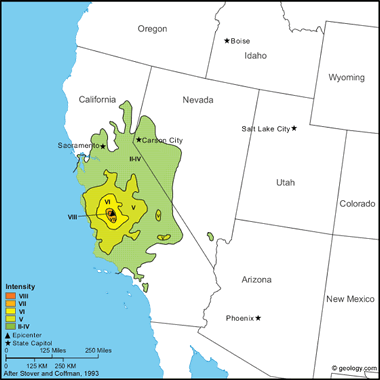
Coalinga Earthquake, 1983: This earthquake caused an estimated $10 million in belongings impairment (according to the American Red Cross) and injured 94 people. Damage was nigh severe in Coalinga, where the eight-block downtown commercial district was almost completely destroyed. Here, buildings having unreinforced brick walls sustained the heaviest damage. Newer buildings, however, such every bit the Banking company of America and the Guarantee Savings and Loan buildings, sustained simply superficial harm. The well-nigh meaning impairment exterior the Coalinga area occurred at Avenal, 31 km southeast of the epicenter.
A disaster assessment by the American Red Cross listed the post-obit statistics on harm in the area: almost destroyed-309 single-family unit houses and 33 apartment buildings; major damage-558 single-family houses, 94 mobile homes, and 39 flat buildings; and minor damage-8ll unmarried-family unit houses, 22 mobile homes, and lxx apartment buildings. Nearly public buildings, including the Metropolis Hall, hospital, schools, fire house, postal service office, and police station, sustained only minor damage.
Only 6 bridges of 60 surveyed in the area sustained measurable structural damage. This damage consisted of hairline cracks and spalling at the top of the support columns, fracturing and displacement of wingwalls and parapets, and settlement of fill.
All public utilities were damaged to some degree. The water system continued to function despite many leaks in its transmission piping. Gas was shut off for several days because of cleaved pipe and leaks, but merely temporary interruptions of electric and phone services were reported. One large section of former physical sewer pipe west of the downtown area partly complanate, simply this organization also connected to function.
In the oil fields about Coalinga, surface facilities such equally pumping units, storage tanks, pipelines, and support buildings were all damaged to some degree. One oil company administration building, about 7 kilometers north of Coalinga, sustained major structural damage and its two brick chimneys were toppled. Subsurface damage, including collapsed or parted well casing, was observed only on 14 of ane,725 active wells.
This earthquake triggered thousands of rockfalls and rockslides as far equally 34 kilometers northwest, 15 kilometers south, and 26 kilometers southwest of the epicenter. Only a few slope failures occurred eastward of the epicenter because of the absence of steep slopes in that direction.
This damaging convulsion was caused by an 0.5-meter uplift of Anticline Ridge northeast of Coalinga, but surface faulting was not observed. Ground and aerial searches immediately after the earthquake revealed ground cracks and fissures within about 10 km of the instrumental epicenter, none of which appeared to represent movement on securely rooted mistake structures. About 5 weeks later on, on June 11, notwithstanding, an aftershock caused surface faulting nearly 12 kilometers northwest of Coalinga.
Felt from the Los Angeles expanse due north to Susanville (Lassen County) and from the coast eastward to western Nevada. Through July 31, more than five,000 aftershocks were recorded, of which 894 had a magnitude of 2.five or larger. Nigh of the larger magnitude shocks were felt in Coalinga. (from: The states Geological Survey Professional person Paper 1527: Seismicity of the U.s., 1568-1989, (revised), by C.W. Stover and J.L. Coffman, 1993, 418 pages) Larger map
Kern Canton Earthquake - six.three - March 15, 1946
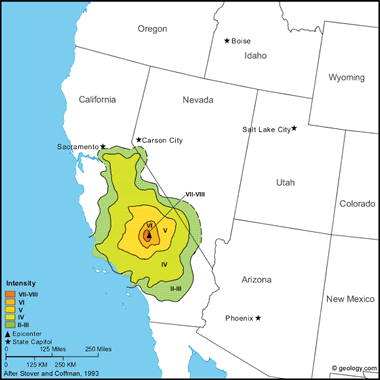
Kern County Earthquake, 1946: The main shock acquired moderate harm at Onyx, about 19 kilometers southwest of the epicenter. Harm to wood, brick, masonry, and concrete was reported to be considerable. Chimneys, walls, plaster, and windows croaky; dishes broke; and plaster, books, and pictures fell. Cracks formed in the ground and concrete along the Los Angeles Aqueduct. Rockslides occurred in the canyons. Elsewhere in the region of Walker Pass and the Southward Fork of the Kern River, adobe houses were damaged, brick chimneys cracked, and plaster fell.
The earthquakes were felt from Commache (Calaveras County) on the north to San Diego (an isolated report) on the due south and from Cambria (San Luis Obispo County) on the coast to Death Valley. Several aftershocks occurred. (from: United States Geological Survey Professional Paper 1527: Seismicity of the U.s., 1568-1989, (revised), past C.W. Stover and J.L. Coffman, 1993, 418 pages) Larger map
Riverside Canton Earthquake - 6.v - December 4, 1948
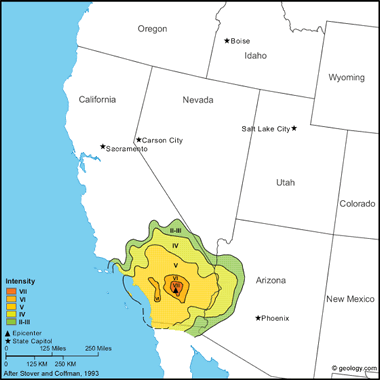
Riverside County Earthquake, 1948: The earthquake probably was caused by deportation on the Mission Creek fault, one of the major branches of the San Andreas fault organisation in southern California. The highest intensities in the area were reported from the upper Coachella Valley from Thousand Palms to White Water, which as well was the about densely populated area most the epicenter.
Considerable structural harm and slight cracks in the ground were observed in Desert Hot Springs. Some minor structural damage also occurred at Palm Springs. At Willis Palms, cracks formed in the ground and cliffs, riverbanks slumped, and springs increased in flow. Landslides and cracks in the ground were reported in the Indio Hills. Felt throughout southern California and at a few towns in western Arizona, southwest Nevada, and northern Baja California. Virtually 72 aftershocks were accurately located in a zone xviii kilometers long, parallel to (but 5 kilometers north of) the trace of the Mission Creek fault. (from: United States Geological Survey Professional Paper 1527: Seismicity of the Us, 1568-1989, (revised), by C.W. Stover and J.L. Coffman, 1993, 418 pages) Larger map
Santa Cruz Mountains Earthquake - 6.9 - Oct 17, 1989
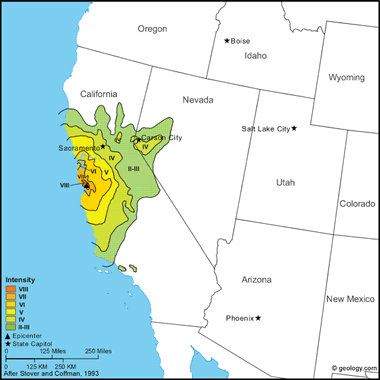
Santa Cruz Mountains Earthquake, 1989: This major earthquake acquired 63 deaths, 3,757 injuries, and an estimated $6 billion in holding damage. It was the largest earthquake to occur on the San Andreas fault since the great San Francisco earthquake in April 1906.
The nigh severe belongings damage occurred in Oakland and San Francisco, well-nigh 100 km n of the fault segment that slipped on the San Andreas. MM intensity IX was assigned to San Francisco'southward Marina District, where several houses collapsed, and to four areas in Oakland and San Francisco, where reinforced-concrete viaducts complanate: Nimitz Throughway (Interstate 880) in Oakland, and Embarcadero Thruway, Highway 101, and Interstate 280 in San Francisco. Communities sustaining heavy damage in the epicentral expanse included Los Gatos, Santa Cruz, and Watsonville.
Liquefaction, as evidenced by sand boils, lateral spreading, settling, and slumping, occurred as far as 110 kilometers from the epicenter. It caused severe damage to buildings in San Francisco'due south Marina commune besides every bit along the coastal areas of Oakland and Alameda in the e San Francisco Bay shore expanse. Liquefaction too contributed significantly to the property impairment in the Santa Cruz and Monterey Bay areas, which lie near the epicentral zone. Structures damaged by liquefaction include buildings, bridges, highways, pipelines, port facilities, airdrome runways, and levees. Subsurface soil conditions, which amplified accelerations in the San Francisco Bay area, strongly influenced structural damage patterns and probably contributed to liquefaction problems in loose, sandy fills underlain by deep, cohesive soil deposits.
Engineered buildings, including those near the epicenter, performed well during the earthquake. Hospital buildings in the region sustained only minor system and corrective damage, and operational interruptions did not occur. Only v schools sustained severe damage, estimated at $81 million.
Most of the spectacular damage to buildings was sustained by unreinforced masonry buildings synthetic of wood-frame roof and floor systems supported by unreinforced brick walls. These structures failed in areas well-nigh the epicenter also equally in areas far from the epicenter, at San Francisco and Monterey. The severe shaking almost Santa Cruz caused heavy damage to the unreinforced masonry buildings in that surface area, particularly in the Santa Cruz Pacific Garden Mall, which consisted of several blocks of unreinforced masonry store buildings.
More than fourscore of the 1,500 bridges in the area sustained minor harm, 10 required temporary supports, and 10 were closed attributable to major structural harm. 1 or more spans collapsed on three bridges. The near severe damage occurred to older structures on poor basis, such every bit the Cypress Street Viaduct (41 deaths) and the San Francisco-Oakland Bay Bridge (i death). Damage to the transportation arrangement was estimated at $1.8 billion.
Nigh of the more than 1,000 landslides and rockfalls occurred in the epicentral zone in the Santa Cruz Mountains. 1 slide, on Land Highway 17, disrupted traffic for most ane month.
The earthquake produced a blueprint of northwest-trending extensional fractures in the n stop of the aftershock zone northwest of the epicenter, but throughgoing right-lateral surface faulting was not found above the rupture defined by the main shock and its aftershocks. Six feet of correct-lateral strike-slip and 4 anxiety of opposite-slip was inferred from geodetic data. The only surface fracturing that might be attributed to primary tectonic faulting occurred along a trace of the San Andreas near Mount Madonna Road in the Corralitos area, where en echelon cracks showed 2 centimeters of right-lateral displacement.
Extensional fractures (maximum net deportation of 92 centimeters) were observed about 12 kilometers northwest of the epicenter, in the Summit Road-Skyland Ridge area, e of Throughway 17, whereas zones of compressional deformation were found along the northeast foot of the Santa Cruz Mountains between Blossom Hill and Palo Alto. In Los Altos and Los Gatos, footing deformation appeared to exist associated closely with zones of heavy structural damage and broken underground utility lines.
Other towns in the area that also experienced severe property damage include Boulder Creek, Corralitos, Hollister, Moss Landing, and several smaller communities in the Santa Cruz Mountains.
This earthquake was felt over about of cardinal California and in function of western Nevada. The rate of aftershock activity decreased quickly with time, but the total number of aftershocks was less than that expected from a generic California earthquake of similar magnitude. Fifty-one aftershocks of magnitude 3.0 and larger occurred during the first twenty-four hours after the main shock, and 16 occurred during the second day. Later on iii weeks, 87 magnitude three.0 and larger aftershocks had occurred. (from: United States Geological Survey Professional Paper 1527: Seismicity of the United States, 1568-1989, (revised), past C.Westward. Stover and J.50. Coffman, 1993, 418 pages) Larger map
San Bernardino Earthquake - 6.iv - April 10, 1947

San Bernardino Earthquake, 1947: This moderate stupor was strongest in the Newberry Springs area, well-nigh 40 kilometers east of Barstow. One schoolhouse was condemned at Newberry Springs, and three adobe and brick houses were damaged severely. Minor damage, including one toppled chimney, fallen walls, cracks in chimneys and physical, and croaky and slumped highways, were reported in the area. Also, cracks formed in the banks of the Mojave River. Felt over almost of the southern half of California, a small function of southwest Nevada, and at several towns in western Arizona. Several light aftershocks occurred. (from: U.s. Geological Survey Professional Newspaper 1527: Seismicity of the U.s., 1568-1989, (revised), by C.Due west. Stover and J.L. Coffman, 1993, 418 pages) Larger map
Find Other Topics on Geology.com:
 Rocks: Galleries of igneous, sedimentary and metamorphic stone photos with descriptions. |  Minerals: Data about ore minerals, gem materials and stone-forming minerals. |
 Volcanoes: Articles near volcanoes, volcanic hazards and eruptions by and present. |  Gemstones: Colorful images and articles about diamonds and colored stones. |
 Full general Geology: Articles almost geysers, maars, deltas, rifts, salt domes, water, and much more! |  Geology Store: Hammers, field bags, mitt lenses, maps, books, hardness picks, gold pans. |
 |  Diamonds: Acquire almost the properties of diamond, its many uses, and diamond discoveries. |
wadsworthladest78.blogspot.com
Source: https://geology.com/earthquake/california.shtml
0 Response to "How Many Single Family Homes Were Destroyed Earthquakes in California?"
Post a Comment